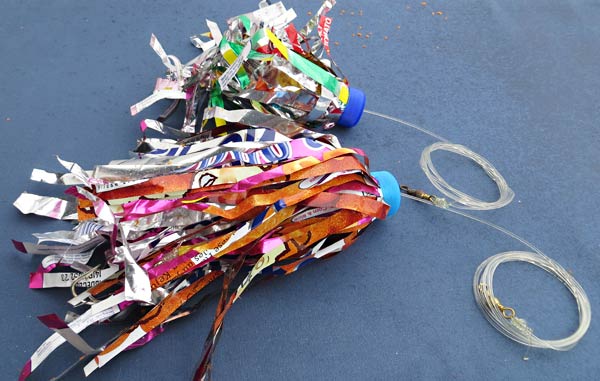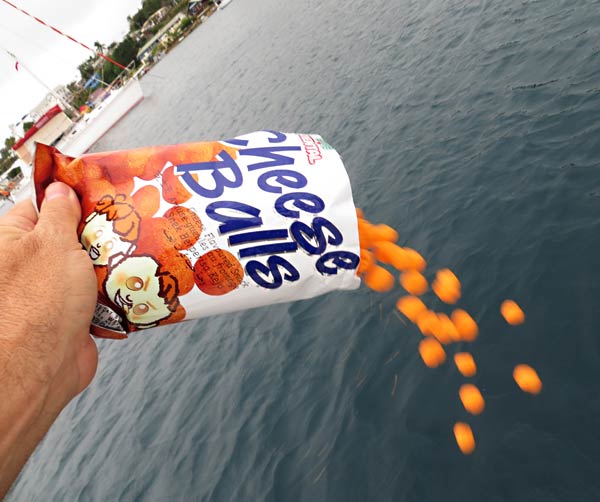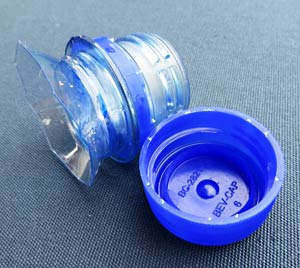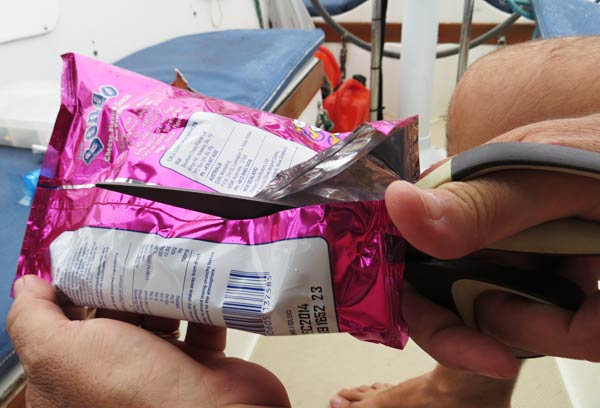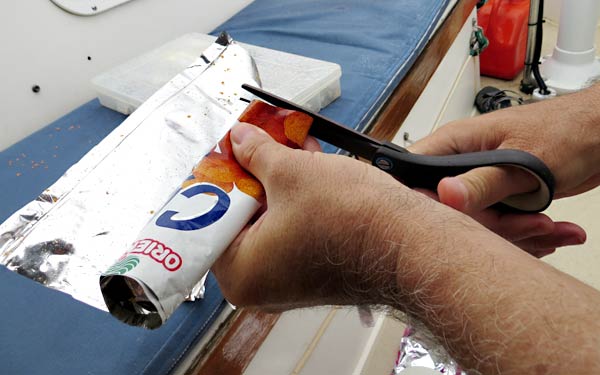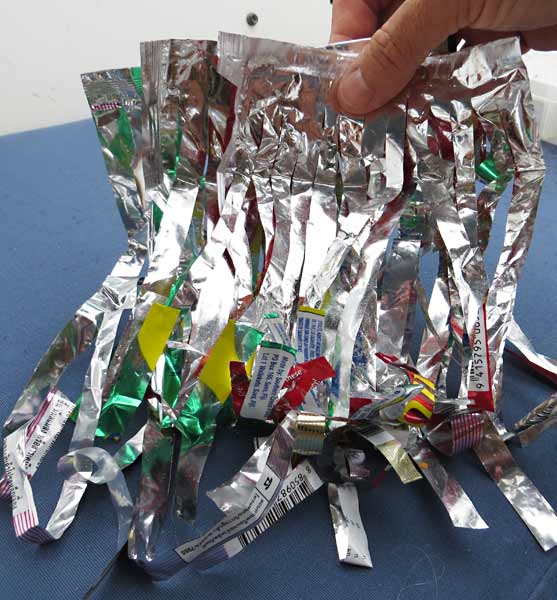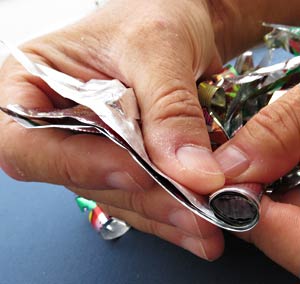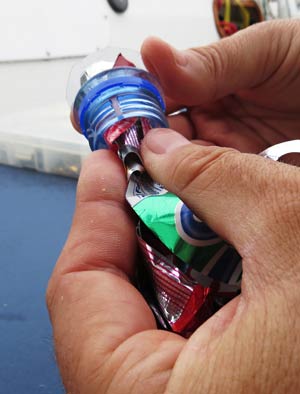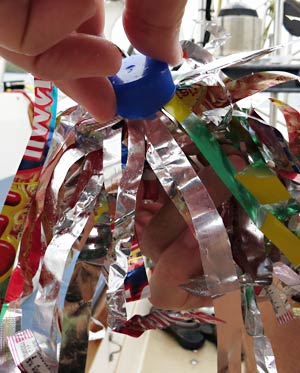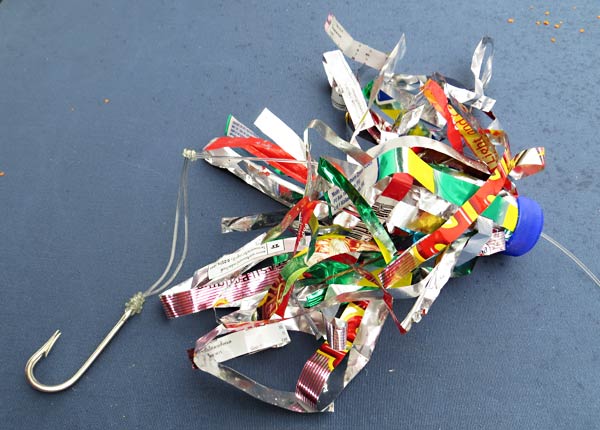The lure that tackle shops don’t want you to know about! (OK, does this sound enough like an infomercial yet?!)
Bill on S/V Island Bound taught me to make these. Thank you Bill! The first time I tried one, I saw a mahimahi porpoising towards the lure from about 300 feet off to port. He hit it immediately – no monkeying around about it. Let this amazing lure be a secret no longer (OK, I guess it wasn’t really a secret). Bill, I hope you don’t mind that I’m posting a step-by-step guide here for all to see and use. Look out fish!
Step 1: Here’s what you’ll need…
Junk food bags. Pick the colors you think the fish you like to eat would like to eat. I used three per lure.
A plastic bottle with a screw top. Soda and water bottles work well. (One per lure.)
A good source for all this stuff is your local dumpster or trash can.
Step 2: Prepare the bags…
Eat the stuff if you don’t mind a nice orange glow to your skin or dying a few days earlier. If that stuff bothers you, feed it to the fish. (Not the fish you’ll be catching. After all, you’ll be eating them in a few hours!)
Step 3: Cut off the bottle top…
Cut off just a little bit of the bottle top. I used a steak knife – this water bottle was thick! Don’t worry about making it too even. I think a little lopsided might make it “swim” better. Keep the cap. You’ll need it.
Step 4: Drill…
Drill a hole just big enough to get your leader through. Make the hole small enough that a stopper knot in the leader won’t pull through the hole. Again, don’t worry about the exact center. Drilling a little off center might also help it swim better.
Step 5: Cut and flatten the bags…
Open the bottom and top of the bag, then cut up the side, just to one side or the other of the seam so that you have a flat sheet of very messy junk food bag.
Step 6: Make hula skirts…
You can loosely roll or fold the bag so that the seam is still sticking out at the top. Then cut the roll into strips about 1/4″ to 1/2″ wide. Make sure you leave about an inch at the seam uncut. (Sorry rest-of-the-world. I’m from America and apparently not capable of thinking in metric.) You should end up with a hula skirt…
Step 7: Roll the hula skirts…
Lay the hula skirts on top of one another (as in the picture above), maybe staggering them a bit. Roll the uncut ends up so that they’ll fit into the bottle top. I used three skirts per lure. Your milage may vary.
If you want the bag’s colored side out on the finished lure, put it inside the roll, though I doubt it matters much. Maybe mix them up?
Step 8: Start putting it together…
Insert the rolled up hula skirts into the bottle top (from the threaded side). Stick all of the uncut end in and leave the streamers hanging out.
Step 9: Fold and screw…
Fold the streamers back over the bottle top and screw on the cap. It’s hard to get the bottle top started. You have to earn that mahi you’re going to catch! I used pliers to tighten the cap.
Step 10: Do all that angler stuff with the line and hook…
Stick your leader through the hole you drilled in the bottle cap, tie on the hook and you’re done. Just a note: I used a stopper knot to keep the hook positioned back by the trailing end of the streamers. You could use a crimp or beads (or maybe something else from a junk food package – get creative).
You probably noticed that there are no weights involved. It seems that part of this lure’s effectiveness is the way it dances on the top of the water. When it breaks the surface, it trails a long stream of bubbles and looks yummy to the things that look yummy to me.
Thats it – you’re done.
Oh yea, now you’ve got to clean all those junk food crumbs off your cockpit cushions!
We hope this works for you as well as it did for us. And again – Thanks Bill!
Update – August 18, 2014…
Oh no, there’s no way my US patent application for these lures will be granted now! I got an email from Chuck on Jacaranda and the prior art goes back even further. His comments in the email are very useful. Here they are:
I LOL about your secret fishing lure. I was shown how to make these type of lures in 1991 while fishing with locals in the Hapaii Group in Tonga. Linda and I did a number of presentations during the PPJ meetings in PV. Part of these presentations was mentioning these lures. Bill and Kat on Island Bound were the first folks who wrote that they made some use of these lures and they worked. We know they work well and they are cheap to make.
You may also see local fisherman in Tuvalu and Kiribati using these lures. We showed some of them this cheap technique on our way north to the Marshall’s one season and the next year on the way south we saw a number of them using these lures.
I offer these suggestions. First instead of carefully cutting the chip bags and then rolling them up, pushing them up thru the cap isn’t necessary (way over engineered). Take 3 small chip bags. Turn one inside out so the shiny Mylar is facing out. Stuff the two bags inside the first bag.. Now put the trimmed bottle inside them and secure with the cap. Cut the bags into strips. Total time less than a minute.
I always put multiple holes in the bottle cap. It acts like a jet head lure adding a stream of bubbles. Secondly I always use 2 hooks in a staggered fashion with one hook closer to the middle of the lure and one just fwd of the edge of the chip bag streamer. Use a short piece of heat shrink on the fwd hook which keeps the hook 180 degrees from the back hook.
Using wire leader will save you from loosing lures as the Wahoo and Dog tooth tunas will bite thru them with very sharp teeth. But using wire leaders will reduce hookups. The mahi have very good eyesight and can see the wire leader. You will still catch them but hookups will be reduced. We have seen the Mahi jet right up to our teaser(clear wine bottle stuffed with chip bags) from over a hundred yards away. Terrific eyesight as if you have ever seen them tracking flying fish you will agree.
We found red in the color combo worked best but check with the local fisherman on what color works best. They are so easy and cheap to make you could make up a number of color combo’s for less than $1 each.
All the best
Chuck
Jacaranda lying Ecuador
Currently in Bogata, Colombia
Chuck has some great fishing tips on his website here: www.jacarandajourney.com. Click the “Other Good Stuff” menu button.
Thanks Chuck!!!

